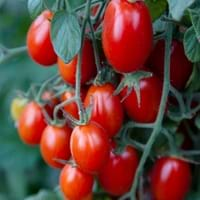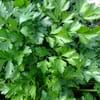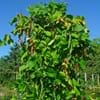Life Span
Annual and Perennial
Perennial
Origin
Hybrid origin, Mexico, Central America, South America
Eastern Europe
Types
Cherry tomato, Beefsteak tomato, Medium tomato
Not Available
Habitat
Loamy soils, Shaded sites
Terrestrial
USDA Hardiness Zone
11-15
4-9
Sunset Zone
A1, A2, A3, H1, H2, 1a, 1b, 2a, 2b, 3a, 3b, 4, 5, 6, 7, 8, 9, 10, 11, 12, 13, 14, 15, 16, 17, 18, 19, 20, 21, 22, 23, 24
1a, 1b, 2a, 2b, 3a, 3b, 4, 5, 6, 7, 8, 9, 10, 11, 12, 13, 14, 15, 16, 17, 18, 19, 20, 21, 22, 23, 24
Habit
Vining/Climbing
Clump-Forming
Flower Color
Yellow
Yellow, Lavender, Blue Violet
Flower Color Modifier
Bicolor
Bicolor
Fruit Color
Red
Not Available
Leaf Color in Spring
Green, Dark Green
Green, Sea Green
Leaf Color in Summer
Green, Dark Green
Green, Sea Green
Leaf Color in Fall
Green, Dark Green
Green, Sea Green
Leaf Color in Winter
Green, Dark Green
Light Green
Leaf Shape
Elliptic, toothed
Lanceolate
Plant Season
Spring, Summer, Fall
Spring, Summer
Sunlight
Full Sun
Full Sun, Partial Sun
Type of Soil
Loam, Sand
Loam, Sand
The pH of Soil
Neutral
Neutral
Soil Drainage
Well drained
Well drained
Bloom Time
Indeterminate
Spring, Late Spring, Early Summer
Tolerances
Drought
Drought
Where to Plant?
Container, Ground, Pot
Ground
How to Plant?
Seedlings, Transplanting
By dividing rhizomes, tubers, Seedlings
Plant Maintenance
Medium
Medium
Watering Requirements
Allow to dry out slightly between watering, Do not water the foliage, Needs 2-3 times watering per week
Average Water Needs, Do Not over Water
In Summer
Lots of watering
Lots of watering
In Spring
Moderate
Moderate
In Winter
Average Water
Average Water
Soil Type
Loam, Sand
Loam, Sand
Soil Drainage Capacity
Well drained
Well drained
Sun Exposure
Full Sun
Full Sun, Partial Sun
Pruning
Remove damaged leaves, Remove dead branches, Remove dead leaves, Remove short branches, Remove short twigs
Remove damaged leaves, Remove dead branches, Remove dead leaves
Fertilizers
Apply 5-10-5 amounts
All-Purpose Liquid Fertilizer
Pests and Diseases
Red blotch
Red blotch
Plant Tolerance
Drought
Drought
Flower Petal Number
Single
Single
Fragrant Bark/Stem
Yes
No
Foliage Texture
Medium
Coarse
Foliage Sheen
Matte
Matte
Attracts
Aphids, Bees, Butterflies, Mosquitos
Hummingbirds
Allergy
Diarrhea, gastro-intestinal problems, Headache, Itchiness, Vomiting
Skin irritation
Aesthetic Uses
As decorated salad
Showy Purposes
Beauty Benefits
Acne, Glowing Skin, Maintains teeth healthy
Not Available
Environmental Uses
Air purification
Air purification
Medicinal Uses
Antioxidants, Metabolism
No Medicinal Use
Part of Plant Used
Fruits, Leaves
Not Available
Other Uses
Cosmetics, Culinary use, For making oil, Repellent
Used as Ornamental plant
Used As Indoor Plant
Sometimes
No
Used As Outdoor Plant
Yes
Yes
Garden Design
Container, Edible, Herb, Vegetable
Alpine, Edging, Mixed Border, Rock Garden, Wall
Botanical Name
LYCOPERSICON esculentum var cerasiforme 'Grape'
IRIS pumila
Common Name
Grape tomato
Dwarf Iris
In Hindi
अंगूर टमाटर
Dwarf Iris
In German
Traube Tomate
Zwergiris
In French
tomate uva
Dwarf Iris
In Spanish
tomate uva
Enano Iris
In Greek
ντομάτα σταφυλιών
νάνος Ίρις
In Portuguese
tomate uva
Dwarf Iris
In Polish
pomidorowa z winogro
Dwarf Iris
In Latin
uva tomatoes
Iris Dwarf
Phylum
Magnoliophyta
Magnoliophyta
Class
Magnoliopsida
Liliopsida
Family
Solanaceae
Iridaceae
Clade
Angiosperms, Asterids, Eudicots
Angiosperms, Monocots
Subfamily
Solanoideae
Iridoideae
Number of Species
Not Available
Not Available
Properties of Grape Tomato and Dwarf Iris
Wondering what are the properties of Grape Tomato and Dwarf Iris? We provide you with everything About Grape Tomato and Dwarf Iris. Grape Tomato doesn't have thorns and Dwarf Iris doesn't have thorns. Also Grape Tomato does not have fragrant flowers. Grape Tomato has allergic reactions like Diarrhea, gastro-intestinal problems, Headache, Itchiness and Vomiting and Dwarf Iris has allergic reactions like Diarrhea, gastro-intestinal problems, Headache, Itchiness and Vomiting. Compare all the properties and characteristics of these two plants. Find out which of these plant can be used as indoor plant. If you are interested to decorate your house and garden, find out aesthetic uses, compare them and select the plant which will beautify your surrounding. Along with beautification, try comparing medicinal and edible uses of Grape Tomato and Dwarf Iris and you can choose the plant having best and most benefits.
Season and Care of Grape Tomato and Dwarf Iris
Season and care of Grape Tomato and Dwarf Iris is important to know. While considering everything about Grape Tomato and Dwarf Iris Care, growing season is an essential factor. Grape Tomato season is Spring, Summer and Fall and Dwarf Iris season is Spring, Summer and Fall. The type of soil for Grape Tomato is Loam, Sand and for Dwarf Iris is Loam, Sand while the PH of soil for Grape Tomato is Neutral and for Dwarf Iris is Neutral.
Grape Tomato and Dwarf Iris Physical Information
Grape Tomato and Dwarf Iris physical information is very important for comparison. Grape Tomato height is 30.00 cm and width 30.00 cm whereas Dwarf Iris height is 10.20 cm and width 15.20 cm. The color specification of Grape Tomato and Dwarf Iris are as follows:
Grape Tomato flower color: Yellow
Grape Tomato leaf color: Green and Dark Green
Dwarf Iris flower color: Yellow, Lavender and Blue Violet
- Dwarf Iris leaf color: Green and Sea Green
Care of Grape Tomato and Dwarf Iris
Care of Grape Tomato and Dwarf Iris include pruning, fertilizers, watering etc. Grape Tomato pruning is done Remove damaged leaves, Remove dead branches, Remove dead leaves, Remove short branches and Remove short twigs and Dwarf Iris pruning is done Remove damaged leaves, Remove dead branches and Remove dead leaves. In summer Grape Tomato needs Lots of watering and in winter, it needs Average Water. Whereas, in summer Dwarf Iris needs Lots of watering and in winter, it needs Average Water.





